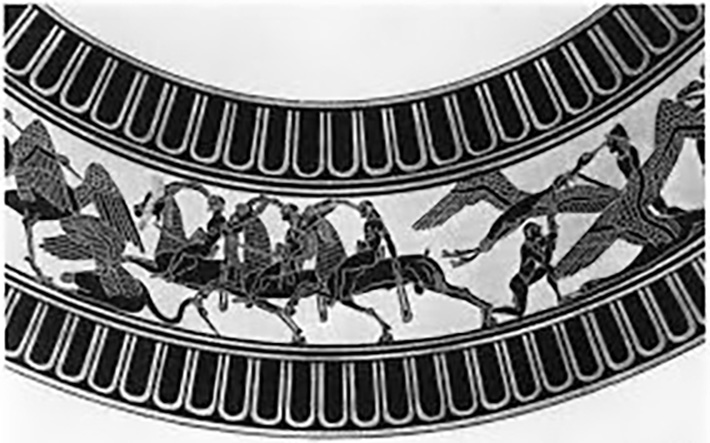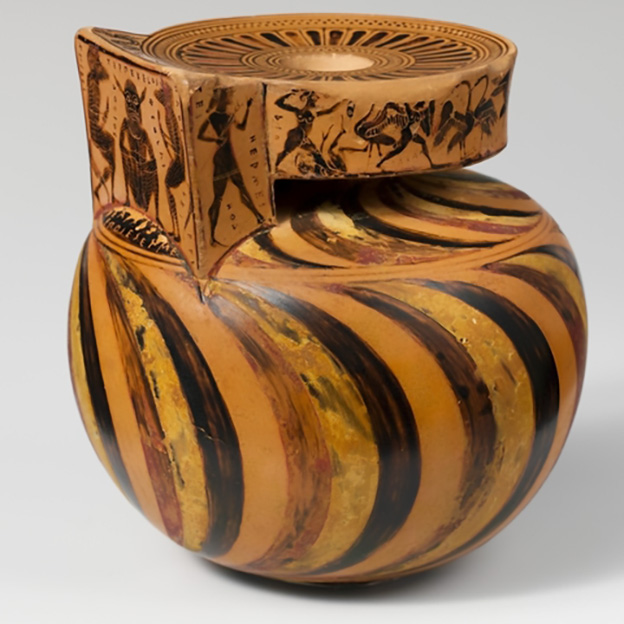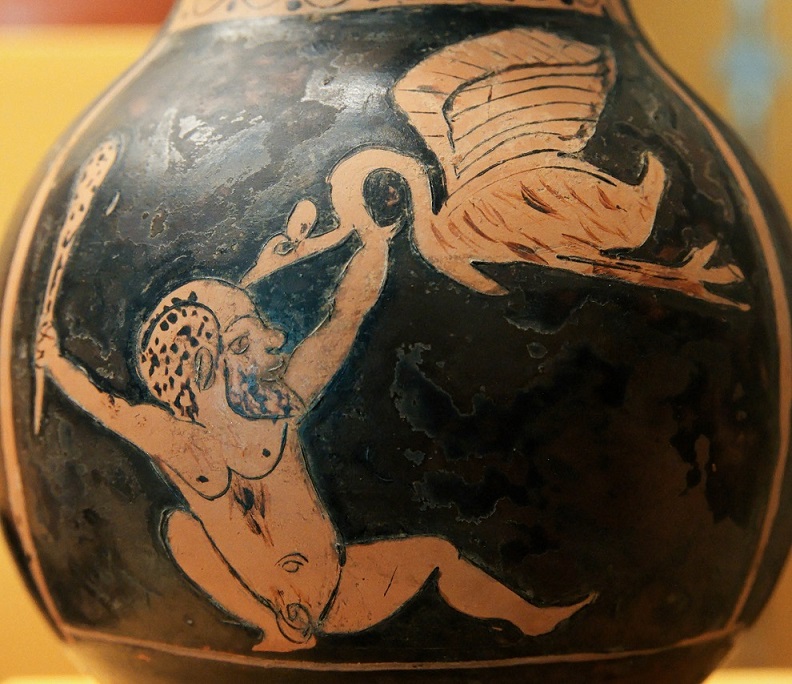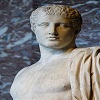Pygmy
The diminutive human tribe
The Pygmies (Greek: Πυγμαῖοι, from the adjective πυγμαῖος, from the noun πυγμή which means: "fist, boxing, distance from elbow to knuckles,"; and from the adverb πύξ "with the fist") were a tribe of diminutive humans in Greek mythology.
According to the Iliad, they were involved in a constant war with the cranes, which migrated in winter to their homeland on the southern shores of the earth-encircling river Oceanus:
Now when the men of both sides were set in order by their leaders,
the Trojans came on with clamour and shouting, like wildfowl,
as when the clamour of cranes goes high to the heavens,
when the cranes escape the winter time and the rains unceasing
and clamorously wing their way to the streaming Ocean,
bringing to the Pygmaian men bloodshed and destruction:
at daybreak they bring on the baleful battle against them.
According to Aristotle in History of Animals, the story is true:
these birds [the cranes] migrate from the steppes of Scythia to the marshlands south of Egypt where the Nile has its source. And it is here, by the way, that they are said to fight with the pygmies; and the story is not fabulous, but there is in reality a race of dwarfish men, and the horses are little in proportion, and the men live in caves underground.

One story in Ovid describes the origin of the age-old battle, speaking of a Pygmy Queen named Gerana (see notes below) who offended the goddess Hera with her boasts of superior beauty, and was transformed into a crane.
In art the scene was popular with little Pygmies armed with spears and slings, riding on the backs of goats, battling the flying cranes. The 2nd-century BC tomb near Panticapaeum, Crimea "shows the battle of human pygmies with a flock of herons".
The Pygmies were often portrayed as pudgy, comical dwarves. They grew to a height of one "pygme"--a "pygme" being the length from a man's elbow to his nuckle-bone (approximately 1 1/2 foot).

In another legend, the Pygmies once encountered Heracles, and climbing all over the sleeping hero attempted to bind him down, but when he stood up they fell off. The story was adapted by Jonathan Swift as a template for Lilliputians.
St. Augustine (354–430) mentions the "Pigmies" in The City of God, Book 16, chapter 8 entitled, "Whether Certain Monstrous Races of Men Are Derived From the Stock of Adam or Noah's Sons."
Later Greek geographers and writers attempted to place the Pygmies in a geographical context. Sometimes they were located in far India, at other times near the Ethiopians of Africa. The Pygmy bush tribes of central Africa were so named after the Greek mythological creatures by European explorers in the 19th century.

NOTES
Gerana was a queen of the Pygmy folk in Greek mythology. She boasted to be more beautiful than the goddess Hera and was transformed by the angry goddess into a crane (Greek: γερανός).
The bird descendants of Gerana waged an eternal war on the Pygmies during their winter migration to the shores of the river Oceanus.
Gerana was otherwise known as Oenoe.
Based on:
Ovid, Metamorphoses 6.89 - 91
Antoninus Liberalis, Metamorphoses, 16
CLASSICAL LITERATURE QUOTES
PYGMIES IN MYTH
Homer, The Iliad 3. 3 ff (trans. Lattimore) (Greek epic C8th B.C.) :
"The clamour of cranes goes hight to the heavens, when the cranes escape the winter time and the rains unceasing and clamorously wing their way to streaming Okeanos (Oceanus), bringing the Pygmaioi (Pygmy) men bloodshed and destruction : at daybreak they bring on the baleful battle against them."
Hesiod, Catalogues of Women Fragment 40A (from the Oxyrhynchus Papyri) (trans. Evelyn-White) (Greek epic C8th or C7th B.C.) :
"To the lands of the Massagetai and of the proud Hemikunes (Hemicynes) (Half-Dog Men), of the Katoudaioi (Catoudaei) (Underground-Folk) and of the feeble Pygmaioi (Pygmies); and to the tribes of the boundless Melanokhrotoi (Melanchroti) (Black-Skins) and the Libys (North-Africans). Huge Gaia (the Earth) bare these to Epaphos--soothsaying people, knowing seercraft by the will of Zeus the lord of oracles, but deceivers, to the end that men whose thought passes their utterance might be subject to the gods and suffer harm--Aithiopes (Ethiopians) and Libys (Libyans) and mare-milking Skythioi (Scythians). For verily Epaphos was the child of the almighty Son of Kronos (Cronus) [Zeus], and from him sprang the dark Libys and high-souled Aithiopes, and the Katoudaioi (Underground-Folk) and feeble Pygmaioi. All these are the offspring of the lord, the Loud-thunderer [i.e. Zeus as the father of Epaphos]."
Hesiod, Catalogues of Women Fragment 43 (from Philodemus on Piety 10) :
"Nor let anyone mock at Hesiod who mentions . . . the Troglodytoi (Troglodytes) and the Pygmaioi (Pygmies)."
Aesop, Fables 294 (from Babrius 26) (trans. Gibbs) (Greek fable C6th B.C.) :
"There were some cranes who came to nibble at a field which a farmer had recently sown with wheat . . . The farmer . . . began throwing rocks at the cranes, crippling a good many of them. As the cranes abandoned the field they cried to one another, ‘Let's run away to the land of the Pygmaioi (Pygmies)!’"
Antoninus Liberalis, Metamorphoses 16 (trans. Celoria) (Greek mythographer C2nd A.D.) :
"Among the people we call Pygmaioi (Pygmies) there was born a girl called Oinoe (Oenoe) who was of flawless beauty but she was graceless by nature and overweening. She cared not a rap for Artemis and Hera. She was married to one of the citizens, Nikodamos (Nicodamus), a good and sensible man, and gave birth to a child called Mopsos (Mopsus). And all the Pygmaioi, who loved to show kindliness, brought her many gifts to celebrate the birth of the child. But Hera found fault with Oinoe for not honouring her and turned her into a crane, elongated her neck, ordained that she should be a bird that flew high. She also caused war to arise between her and the Pygmaioi. Yearning for her child Mopsos, Oinoe flew over houses and would not go away. But all the Pygmaioi armed themselves and chased her away. Because of this there arose a state of war then as well as now between the Pygmaioi and the cranes."
Aelian, On Animals 15. 29 (trans. Scholfield) (Greek natural history C2nd A.D.) :
"As to the race of Pygmaioi (Pygmies) I have heard that they are governed in a manner peculiar to themselves, and that in fact owing to the failure of the male line a certain woman became queen and ruled over the Pygmaioi; her name was Gerana, and the Pygmaioi worshipped her as a god, paying her honours too august for a human being. The result was, they say, that she became so puffed up in her mind that she held the goddesses of no account. It was especially Hera, Athena, Artemis, and Aphrodite that, she said, came nowhere near her in beauty. But she was not destined to escape the evil consequences of her diseased imagination. For in consequence of the anger of Hera she changed her original form into that of a most hideous bird and became the crane of today and wages war on the Pygmaioi because with their excessive honours they drove her to madness and to her destruction."
Aelian, On Animals 3. 23 :
"Alexandros (Alexander) of Myndos [Greek writer C1st A.D.] asserts that when they [the storks] reach old age they pass to the island of Okeanos (Oceanus) and are transformed into human shape, and that this is a reward for their filial piety towards their parents, since, if I am not mistaken, the gods especially desire to hold up there if nowhere else a human model of piety and uprightness, for in no other country under the sun could such a race continue to exist. This is in my opinion no fairy-tale, otherwise what was Alexandros' design in relating such marvels when he had nothing to gain from it?"
Ovid, Metamorphoses 6. 90 (trans. Melville) (Roman poet C1st B.C. to C1st A.D.) :
"The Pygmaea (Pygmy) matron's doom, her pitiable doom, when Juno [Hera] won the contest and transformed her to a crane and made her fight her folk, her kith and kin."
Philostratus the Elder, Imagines 2. 22 (trans. Fairbanks) (Greek rhetorician C3rd A.D.) :
"[Ostensibly a description of an ancient Greek painting at Neapolis (Naples) :] Herakles (Heracles) among the Pygmaioi (Pygmies). While Herakles is asleep in Libya after conquering Antaios (Antaeus), the Pygmaioi set upon him with the avowed intention of avenging Antaios; for they claim to be brothers of Antaios, high-spirited fellows, not athletes, indeed, nor his equals at wrestling, but earth-born (gêgenes) and quite strong besides, and when they come up out of the earth the sand billows in waves. For the Pygmaioi dwell in the earth just like ants and store their provisions underground, and the food they eat is not the property of others but their own and raised by themselves. For they sow and reap and ride on a cart drawn by pigmy horses, and it said that they use an axe on stalks of grain, believing that these are trees. But ah, their boldness! Here they are advancing against Herakles and undertaking to kill him in his sleep; though they would not fear him even if he were awake. Meanwhile he sleeps on the soft sand, since weariness has crept over him in wrestling; and, filled with sleep, his mouth open, he draws full breaths deep in his chest, and Hypnos (Sleep) himself stands over him in visible form, making much, I think, of his own part in the fall of Herakles. Antaios also lies there, but whereas art paints Herakles as alive and warm, it represents Antaios as dead and withered and abandons him to Ge (Gaea, the Earth).
The army of the Pygmaioi envelops Herakles; while this one phalanx attacks his left hand, these other two companies march against his right hand as being stronger; bowmen and a host of slingers lay siege to his feet, amazed at the size of his shin; as for those who advance against his head, the Pygmaios (Pygmy) King has assumed the command at this point, which they think will offer the stoutest resistance, and they bring engines of war to bear against it as if it were a citadel--fire for his hair, mattocks for his eyes, doors of a sort for his mouth, and these, I fancy, are gates to fasten on his nose, so that Herakles may not breathe when his head has been captured. All these things are being done, to be sure, around the sleeping Herakles; but lo! he stands erect and laughs at the danger, and sweeping together the hostile forces he puts them in his lion's skin, and I suppose he is carrying them to Eurystheus."
Pliny the Elder, Natural History 7. 26 (trans. Rackham) (Roman encyclopedia C1st A.D.) :
"This tribe [the Pygmies] Homer has also recorded as being beset by cranes. It is reported that in springtime their entire band, mounted on the backs of rams and she-goats and armed with arrows, goes in a body down to the sea and eats the cranes' eggs and chickens, and that this outing occupies three months; and that otherwise they could not protect themselves against the flocks of cranes would grow up; and that their houses are made of mud and feathers and egg-shells."
Nonnus, Dionysiaca 14. 33 ff (trans. Lind) (Greek epic C5th A.D.) :
"Like Thrakian cranes, when they fly from the scourge of winter and floods of stormy rain to throw their great flocks against the heads of Pygmaioi (Pygmies) round the waters of Tethys, and when with sharp beaks they have destroyed that weak and helpless race, they wing their way like a cloud over the horn of Okeanos (Oceanus)."
PYGMIES IN LEGEND
The Pygmies were also described as an actual African tribe in various ancient geographical treatises.
Ctesias, Indica (summary from Photius, Myriobiblon 72) (trans. Freese) (Greek historian C4th B.C.) :
"In the middle of India there are black men, called Pygmaioi (Pygmies), who speak the same language as the other inhabitants of the country. They are very short, the tallest being only two cubits in height, most of them only one and a half. Their hair is very long, going down to the knees and even lower, and their beards are larger than those of any other men. When their beards are full grown they leave off wearing clothes and let the hair of their head fall down behind far below the knees, while their beard trails down to the feet in front. When their body is thus entirely covered with hair they fasten it round them with a girdle, so that it serves them for clothes. They are snubnosed and ugly. Their sheep are no bigger than lambs, their oxen, asses, horses, mules, and other beasts of burden about the size of rams. Being very skilful archers, 3000 of them attend on the king of India. They are very just and have the same laws as the Indians. They hunt the hare and the fox, not with dogs, but with ravens, kites, crows, and eagles."
Philostratus, Life of Apollonius of Tyana 3. 45 - 47 (trans. Conybeare) (Greek biography C1st to C2nd A.D.) :
"[The C1st A.D. prophet Apollonios of Tyana asked the Indian sage Iarkhos (Iarchus)] about the Men who live Underground (anthropoi hypogen) and the Pygmaioi (Pygmies) . . . and larkhas answered his questions thus : ‘. . . As to the Pygmaioi, he said that they lived underground (hypogeioi), and that they lay on the other side of the Ganges and lived in the manner which is related by all.’"
Philostratus, Life of Apollonius of Tyana 6. 1 :
"We meet in them [both Aithiopia (Ethiopia) and India] with races of Pygmaioi (Pygmies)."
Philostratus, Life of Apollonius of Tyana 6. 23 - 25 :
"The Nasamones and the Androphagoi (Man-Eaters) and the Pygmaioi (Pygmies) and Skiapodes (Sciapods, Shadow-Foots) people are also tribes of Aithiopia (Ethiopia), and they extend as far as the Okeanos Aithiopos (Ethiopian Ocean), which no mariners ever enter except as castaways who do so against their will."
Eusebius, Treatise Against Hierocles 21 (trans. Jones) (Greek rhetorician C4th A.D.) :
"He [Apollonios of Tyana] also asked them [the Brahmans of India] about . . . the Pygmaioi (Pygmies) . . . and Iarkhas (Iarchus) instructed him about the Pygmaioi, and told him that they were indeed people dwelling underground, but spent their lives on the other side of the river Ganges."
Pliny the Elder, Natural History 4. 44 (trans. Rackham) (Roman encyclopedia C1st A.D.) :
"This whole region [the Black Sea coast of Thrace] was occupied by the Scythian tribe called the Ploughmen, their towns being . . . And Gerania, stated to have been the abode of the race of Pygmaei (Pygmies): their name in the local dialect used to be Catizi, and there is a belief that they were driven away by cranes."
Pliny the Elder, Natural History 5. 109 :
"The district of Berecynthus, Nysa and Trallis [in the region of Caria and Phrygia in Asia Minor] . . . is washed by the river Eudon and the Tehbais flows through it; some record that a race of Pygmae (Pygmies) formerly lived in it."
Pliny the Elder, Natural History 6. 70 :
"In the region to the south of the Ganges [River of India] the tribes are browned by the heat of the sun to the extent of being coloured, though not as yet burnt black like the Aethiopes (Ethiopians); the nearer they get to the Indus the more colour they display. We come to the Indus immeditatly after leaving the Prasii, a tribe in whose mountain regions there is said to be a race of Pygmaei (Pygmies)."
Pliny the Elder, Natural History 6. 187 :
"Some writers have even reported a race of Pygmaei (Pygmies) living among the marshes in which the Nile rises."
Pliny the Elder, Natural History 7. 26 :
"Megasthenes [Greek historian C4th B.C.] tells . . . [of the Astomoi tribe who live near the source of the Ganges in India and] beyond these in the most outlying mountain region we are told of the Three-Span (trispithami) Pygmae (Pygmies) who do not exceed three spans, that is, twenty-seven inches, in height; the climate is healthy and always spring-like, as it is protected on the north by a range of mountains; this tribe Homer has also recorded as being beset by cranes. It is reported that in springtime their entire band, mounted on the backs of rams and she-goats and armed with arrows, goes in a body down to the sea and eats the cranes' eggs and chickens, and that this outing occupies three months; and that otherwise they could not protect themselves against the flocks of cranes would grow up; and that their houses are made of mud and feathers and egg-shells. Aristotle says that the Pygmae (Pygmies) live in caves, but in the rest of this statement about them he agrees with the other authorities."
Nonnosus, History (summary from Photius, Myriobiblon 3) (trans. Freese) (Roman historian C6th A.D.):
"During his voyage from Pharsan [near Ethiopia on the Red Sea], Nonnosos [ambassador of the Roman Emperor Justinian C6th A.D.], on reaching the last of the islands, had a remarkable experience. He there saw certain creatures [the Pygmies] of human shape and form, very short, black-skinned, their bodies entirely covered with hair. The men were accompanied by women of the same appearance, and by boys still shorter. All were naked, women as well as men, except for a short apron of skin round their loins. There was nothing wild or savage about them. Their speech was human, but their language was unintelligible even to their neighbours, and still more so to Nonnosos and his companions. They live on shell-fish and fish cast up on the shore. According to Nonnosus, they were very timid, and when they saw him and his companions, they shrank from them as we do from monstrous wild beasts."
PYGMIES MISCELLANY
Philostratus the Elder, Imagines 1. 5 (trans. Fairbanks) (Greek rhetorician C3rd A.D.) :
"[Ostensibly a description of an ancient Greek painting at Neapolis (Naples) :] About Neilos (the River Nile) the Pekheis (Pecheis) (Dwarfs) are sporting, children no taller than their name implies [i.e. pykheis means ‘cubit-tall’]; and Neilos (the Nile) delights in them for many reason, but particularly because they herald his coming in great floods for the Egyptians. At any rate they draw near and come to him seemingly out of the water, infants dainty and smiling, and I think they are not without the gift of speech also. Some sit on his shoulders, some cling to his curling locks, some are asleep on his arms, and some romp on his breast. And he yields them flowers, some form his lap and some from his arms, that they may weave them into crowns and, sacred and fragrant themselves, may have a bed of flowers to sleep upon. And the children climb up one on another with sistra in their hands, instruments the sound of which is familiar to that river. Crocodiles, however, and hippopotami, which some artists associate with Neilos (the Nile) in their paintings, are now lying aloof in its deep eddies so as not to frighten the children. But that the river is Neilos (the Nile) is indicated, my boy, by symbols of agriculture and navigation, and for the following reason : At its flood Neilos (the Nile) makes Egypt open to boats; then, when it has been drunk up by the fields, it gives the people a fertile land to till."

Sources
Aristotle, History of Animals. Translated by D'Arcy Wentworth Thompson. Internet Classics Archive.
Homer, The Iliad of Homer. Translated and with an Introduction by Richmond Lattimore. The University of Chicago Press, 1961.
Kubiĭovych, Volodymyr and Shevchenka, Naukove tovarystvo im. Ukraine: A Concise Encyclopaedia. University of Toronto, 1963.
Mandeville, John, The Travels of Sir John Mandeville: The Fantastic 14th-Century Account of a Journey to the East,
Ritson, Joseph, Fairy Tales, Now First Collected: To which are prefixed two dissertations: 1. On Pygmies. 2. On Fairies, London, 1831, (Adamant Media Corporation, 2004)
GREEK
Homer, The Iliad - Greek Epic C8th B.C.
Hesiod, Catalogues of Women Fragments - Greek Epic C8th - 7th B.C.
Aesop, Fables - Greek Fables C6th B.C.
Ctesias, Indica - Greek History C5th B.C.
Antoninus Liberalis, Metamorphoses - Greek Mythography C2nd A.D.
Aelian, On Animals - Greek Natural History C2nd - 3rd A.D.
Philostratus the Elder, Imagines - Greek Rhetoric C3rd A.D.
Philostratus, Life of Apollonius of Tyana - Greek Biography C2nd A.D.
Eusebius, Treatise Against Hierocles - Greek Rhetoric C4th A.D.
Nonnus, Dionysiaca - Greek Epic C5th A.D.
ROMAN
Ovid, Metamorphoses - Latin Epic C1st B.C. - C1st A.D.
Pliny the Elder, Natural History - Latin Encyclopedia C1st A.D.
Nonnosus, History - Latin History C6th A.D.
BYZANTINE
Photius, Myriobiblon - Byzantine Greek Scholar C9th A.D.
"Theoi"
"Wikipedia"












